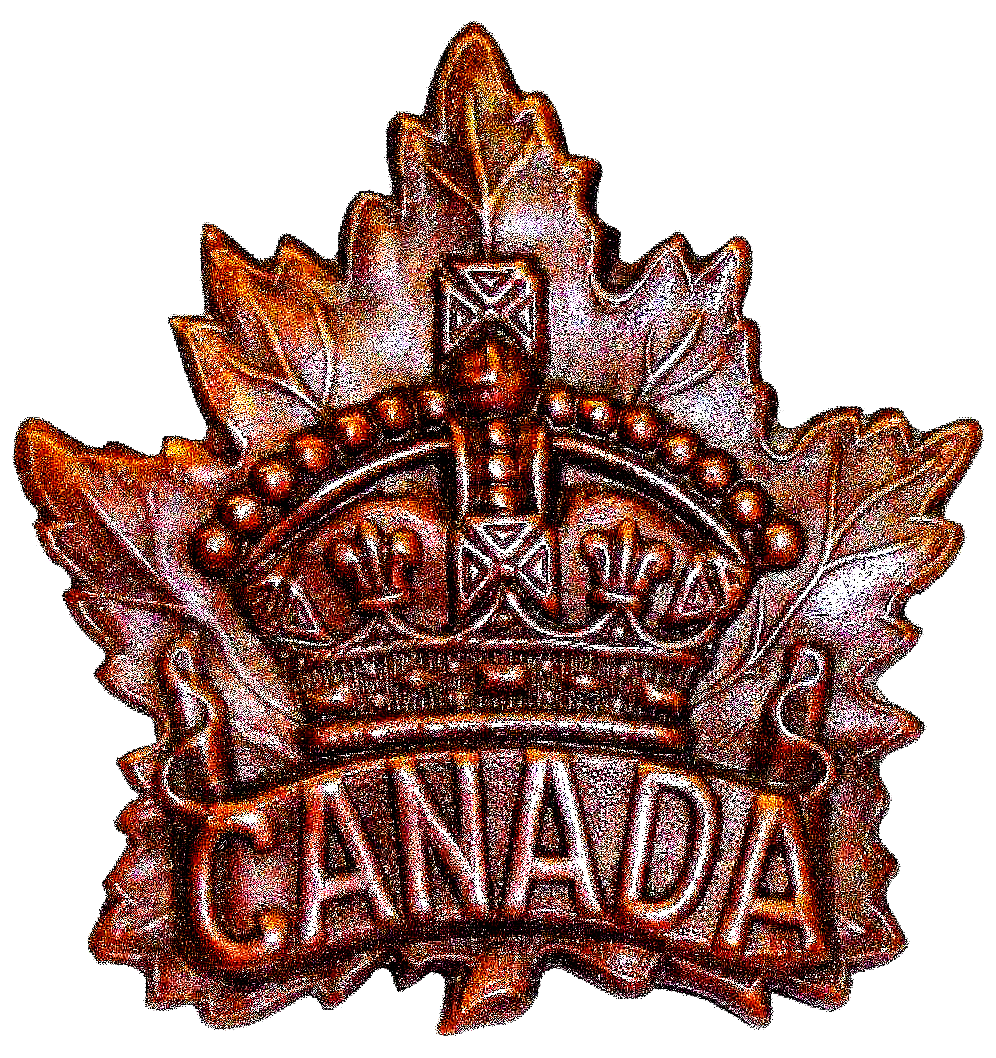
OPCMH
ORGANIZATION
for
PRESERVATION
of
CANADIAN
MILITARY
HERITAGE |
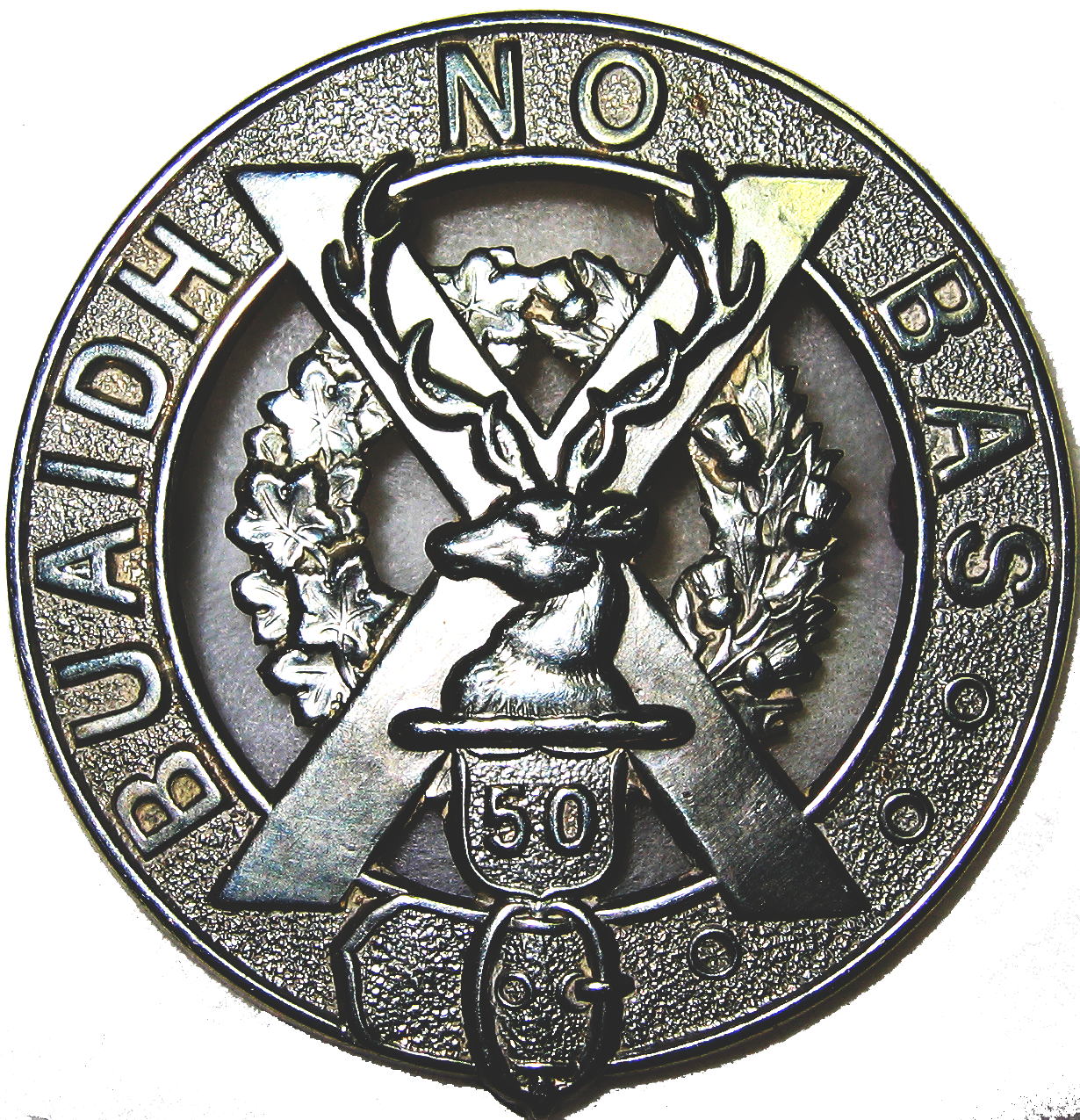
OPCMH
Visitor No.:
1492189
since
2015-03-21
| |
HISTORY OF WORK POINT BARRACKS
by Jack Bates
PART 4 — 1907 to 1918
1918
Daily Colonist
February 2, 1918
MILITARY NOTES
Colonel Duff Stuart, who up to the time of the appointment of Major General R.G.E. Leckie, C.M.G., was O.C. in this military district, and who subsequently automatically assumed the command of the 23rd Infantry Brigade, Vancouver, is back in Victoria temporarily reassuming his former office to “carry on” in the absence in Ottawa of General Leckie.
Letter
F. 8505
20th July, 1918.
RECORDS ROOM
606316 July 22 '18
P.W. DEPT.
Wm. Henderson, Esq.,
Architect, Victoria, B.C.
Re: 18 cell building to be erected at
Detention Barrack, Esqumalt, B.C.
I beg to inform you that the erection of a 18 – cell building at the Detention barracks, Esquimalt, B.C., has been awarded to Messrs. Knott & Jones, of Victoria, B.C., for the sum of $6,490.00. The contractors have been advised accordingly and informed that you will furnish them with a copy of the drawings and specifications. Please do this at once.
Attached you will find copy of my letter of even date to the contractors.
Enclos.
H/KM
Acting Chief Architect.
_________________
Daily Colonist
August 16, 1918
DEMOBILIZED, BUT IS NOT DISBANDED
Fifth Regiment, C.G.A., Reverts to Pre-War Status, as Result of
District Order of Recent Date
Demobilization of the 5th Regiment, C.G.A., took place yesterday, the order for this having come out in District Orders a few days ago. The impression seems to have been circulated that the unit, which has been one of the oldest histories of the military units of the west, has been disbanded. This is not so. The force has simply been demobilized from active service, for which it was mobilized on August 2, 1914, at the outbreak of hostilities, and now reverts to its pre-war status as an active militia unit, Lieut. Col. Angus and other officers still remaining attached to the force.
The band maintains its identity as the 5th Regiment Band, and will probably continue to be heard on numerous occasions, providing concerts during the winter and summer months as it did in the years before the war. Doubtless on occasion the unit will still be seen on parade, so that the historic name of the 5th regiment is still attached to a force potentially as strong as that to which the title was given.
August 25, 1918
SOME OF THE OFFICERS WHO HAVE COMMANDED HISTORIC UNIT
ORIGIN AND HISTORY OF “DANDY FIFTH”
Story of the Old Unit Which Proved the Foundation of British Military Organization
in Province of British Columbia – Some Interesting Reminiscences
PAST AND PRESENT OFFICERS OF CORPS
From Regiment Was Sent Overseas First Active Service Draft From This
Western Section of Canada – List of Some Who Gained Distinction in Great War
Tomorrow will be the anniversary of the departure of the first overseas draft of men from the Fifth Regiment, C.G.A., and the fact, coupled with the recent demobilization of the unit, to pre war status, makes timely a history of the origin and achievements of the unit.
Early in April, 1877, Russia declared war upon Turkey, and two months later her army crossed the Danube.
European opinion on the quarrel between the two warring nations differed, and for a time it seemed likely that other powers would be drawn into the conflict. The Russians were advancing upon Constantinople, and Britain, realizing that the occupation of that city by them would be a menace to the Indian Empire, ordered the Mediterranean fleet, which was lying in Besika Bay, near the mouth of the Dardanelles, to proceed through he Strait and the Sea of Marmora, to the Turkish capital, ostensibly for the protection of British life and property there. Relations between Britain and Russia were close to the breaking point.
Felt Far Away
In America, far from the scenes of the Russo-Turko conflict, there were evidences of this unfriendly feeling.
The steamship Cimbria appeared off the Maine coast within fifty miles of St. John, N.B., with a large body of Russian seamen and a cargo of heavy rifled guns on board. This, combined with the many authentic accounts of meditated marauding descents by Fenians, who were gathering in American centres, taking advantage of the possibility of Britain being occupied with Russia, caused Canada to take notice of developments. All the militia units on the American frontier, extending 500 miles from Sherbrooke to Lake Huron, were ordered to be in readiness. Guns and howitzers were placed in positions at certain lake ports, fitted with ship carriages, to arm steamers which were prepared to receive them. On May 24 and July 13 a large force was mobilized at Montreal. That portion of the Dominion to the west of the Great Lakes was, as now, forgotten, until a fleet of five Russian warships dropped anchor in San Francisco Bay. The British Pacific fleet, for which Esquimalt was the base, was cruising in South American waters, leaving nothing to prevent a raid on Victoria, Nanaimo and New Westminster, other than H.M. frigate Opal and gunship Rocket.
Form Militia Unit
Lieut. General Edw. Selby-Smith, commanding the Canadian Militia, had in 1875 recommended certain protection for the British Columbia coast towns, but the recommendations were not heeded until the need was obvious to the government at Ottawa.
Word was received at Victoria that one of the Russian vessels had left San Francisco and proceeded north. There was wild excitement in Victoria. Money was withdrawn from the banks and taken to Port Townsend for safety, and the citizens prepared for defence. It was during this period of preparation that the unit of the Canadian Militia, now known as the 5th (British Columbia) Regiment of Canadian Garrison Artillery had its inception.
Captain F. Robinson, of the Opal loaned pieces of ordnance to the Canadian Militia, and Lieut. Col. C.F. Houghton, Deputy Adjutant General, M.D. No. 11, called for volunteers to man them. The Russian ship arrived, she sailed into Esquimalt without a courtesy and, figuratively speaking, disdainfully smiled upon the two small ships there to oppose her. Captain Robinson immediately boarded her, and learned she was the Russian flagship. Not in the least bit daunted he ordered the Admiral to hoist his anchor and depart within twenty four hours or make the necessary salute. The Russian took advantage of a wind blowing towards the American coast and sailed for Port Townsend.
Volunteers Respond
In the meantime the D.A.G.’s call for volunteers had been answered. Three companies of artillery were formed, two of which were commanded by Captains Dupont and Michael David G. McNaughton, who had been a sergeant in the 10th Battery, New Brunswick Brigade of Artillery, and who possessed a first class certificate from the School of Gunnery at Kingston, was one of the volunteers. His knowledge of gunnery soon became apparent, and he was detailed to instruct the embryonic artillerymen. Mr. McNaughton still resides in Victoria, at 165 Beechwood Ave., but there are very few of the present Victorians who are aware that he was the first qualified gunner of the Canadian Militia in the province.
March 3, 1878, saw the end of the Turkish-Russian war, the treaty of San Stefano, signed on that date when the Russian army lay encamped at the gates of Constantinople, being the dictation of a relentless power to a crushed and helpless state. That, at least, was the British opinion of that time.
Government Awake
The Canadian Government, now being fully awake, proceeded with the protection of Esquimalt and Victoria. Lieut. Col. D.T. Irwin (Captain, Royal Artillery) Inspector of Artillery, arrived in Victoria May 27, 1878, and with Captain Robinson, senior Naval Officer, and Lieut. Col. Houghton, made a careful examination of the coast, with a view to determine upon the best sites for defensive works. Rear Admiral de Horsey, Commander in Chief of the Pacific, afterwards detailed Captain Bedford, H.M.S. Shah; and Captain Burrows, Royal Marine Artillery; and Gunnery Lieut. Lindsay, H.M.S. Shah, to assist in this important duty.
As a result of the survey ten pieces of ordnance was placed in position for the protection of Esquimalt and Victoria harbors.
The actual work of construction began on J 10, 1878, and was completed August 30. The labor was performed by civilian laborers, and volunteers, and from the artillery companies, who gave their services gratuitously. The guns were transported and mounted by a naval detachment under the direction of Captain F. Robinson, H.M.S. Opal.
These fortifications were a great pride to Victorians, and one of the delights of the time was inspection visits on Sundays and holidays. Visitors came at less than orthodox times, and stores became missing as a result. The D.A.G. in his report of December 21, 1878, mentions that “the door of one of the storehouses has been broken into, and a wheelbarrow stolen therefrom.”
Sunken Batteries
As the four batteries erected have long since been demolished, and replaced by more modern ones, it is now quite safe to describe where they were and of what they consisted. Finlayson and Victoria Point Batteries (Beacon Hill) were each composed of two 64 pr R.M.L.; Macaulay Battery had three 7 inch 61/2 ton R.M.L. and Brother’s Island Battery had one 8 inch 9 ton R.M.L. and two 64 pr R.M.L. The general nature of the works was that of sunken barbette batteries. These guns were described as “rather formidable ordnance.”
It was also Lieut. Col. Irwin’s duty properly to organize the three volunteer companies of artillery into a battery of garrison artillery, and to instruct it. Pursuant to these instructions, he arranged for a systematic course of drills and lectures. In his report, he mentioned “the high rate of wages paid labor and limited population of Victoria placed almost insuperable difficulties in the way of the establishment of anything like an efficient artillery force to man these guns and maintain an effective fire against ships in motion, a duty requiring the greatest possible amount of training and intelligence on the part of the gunners. The history of the 5th Regiment C.G.A. will show that the “insuperable difficulties” were imaginary, that the gunners had the intelligence, that they assimilated a great amount of training, and when they were needed they were at hand.
As result of Lieut. Col. Irwin’s efforts the organization of the Victoria Battery of Garrison Artillery was completed. The following officers: Captain C.T. Dupont; 1st Lieut. D.G. McNaughton; and 2nd Lieut. A.W. Jones, were gazetted as from 19th July, 1878.
Seymour Battery
The Seymour Battery was formed in New Westminster on October, 1878, the Lieutenant commanding being Geo. Pettendrigh, the late Captain 3rd Foot, East Kent Regt. (The Buffs). The second Lieutenant was Wm. N. Bole, better known to present readers as Judge Bole. The armament of this battery early in 1879 consisted of two field guns, probably relics of the Hudson’s Bay Company regime, quite unserviceable, owing to the rotten condition of their carriages, one being reported as utterly useless, and the other scarcely safe for practice with shot or shell, and totally unfit to be moved. The battery harness was in the possession of a Mr. Murray, and he refused to give it up until his claim for rent was settled by the Militia. In May 1878, and December 21, 1878, the D.A.G. of the district recommended the battery be equipped with 7 pounder Abyssinian guns.
From 1878 until 1883 the Victoria Battery performed routine drill, gaining considerable proficiency.
Provided Guard
In September 181, the Marquise of Lorne, the then Governor General and H.R.H. the Princess Louise, arrived at Victoria, and for two months sojourned at Carey Castle. The two Artillery Batteries and two companies of Victoria Rifles provided a guard at the castle, each battery and company doing duty for a week alternately. The weeks the Seymour Battery performed this duty must have been a pleasant relaxation from the worry of its rotten gun carriages and seized harnesses.
Until 1883 there is very little to record of the Seymour Battery; there is no doubt its troubles were continuous, and there is every reason to believe that in his reports of 1879 to 1883 inclusive, the Deputy Adjutant General recommended that the battery be equipped with 7 pounder Abyssinian guns.
Picturesque Volunteers
In 1860 there existed in Victoria “The Vancouver Island Volunteer Rifle Corps” the Colonel of which was Sir James Douglas, Commander in Chief of the colonies of British Columbia and Vancouver Island. A few of the pioneer families possess pictures of groups of these riflemen, dressed in a uniform very much like the present day outfit of a lumberjack, and all bewhiskered like the raiders of the Spanish Main. Another link is the few remaining copies of the “Volunteer’s Manual” compiled by Lieut. E.C. Sparshott, R.M.L.I., at English Camp, San Juan Island, and published in 1861, for the Rifle Corps and dedicated to Colonel James Douglas, C.B.
The negro population, which was considerable in the sixties, had a volunteer infantry company. This unit was formed as an expression of loyalty to Great Britain, but had no official existence, and, though its career was a useful one, it was short lived.
Confederation
British Columbia had become part of the Dominion of Canda in 1871, and under authority of the Canadian Militia Act two companies of Rifles were formed in Victoria, one in Nanaimo and one in New Westminster. The Victoria companies were in command of Major Roscoe, Captains H. Wolfenden and Vinter were in charge of companies No. 1 and 2 respectively. Other officers were Captains E.H. Fletcher, Geo. Jay and Roland Green.
After the formation of the Artillery Batteries the preference for the more elite branch of the service was soon shown by the falling off of enlistments in the Rifles. To offset this, the rifle companies in Victoria were united and changed into an artillery battery. British Columbia was then possessed of three batteries of artillery. The need for closer relationship between these batteries, for training and administration was soon apparent, and a movement was started for their formation as a regiment.
Garrison Artillery
In accordance with the Canadian Gazette of 13th October 1883, the Victoria and Seymour Batteries of Garrison Artillery and the companies of the Victoria Rifles were united into a Regiment of Artillery, and designated “The British Columbia Provisional Regiment of Garrison Artillery.”, and Captain Charles Thomas Dupont became Major Commanding. Other officers of the Regiment were Captains A.W. Jones, J.L. Raynor, W.H. Dorman, and Richard Wolfenden. Lieutenants W. Shears, G.A. Kefer, Geo. Jay and Surgeon J.B. Matthews, M.R.C.S., L.S.Apoth. Staff Sergeant Kinsella, C.A. was promoted to regimental Sergeant major. Other N.C.O.’s were sergeants Ross Monro, Robt. J. Plummer, John M and George Langley. Most of these old artillerymen are still with us, retaining a military bearing and physique which speaks well of their soldierly days.
The first recorded duty of the Regiment was to furnish a guard of honor to the Lieutenant Governor at the Legislative Assembly, 3rd December 1883. On that parade a gunner was noticed wearing a civilian felt hat. Just a reading of the Regimental Order on this incident would be enough to cause a modern adjutant to suffer all the effects of shell shock.
On July 23, 1884, the Regiment went under canvas at Beacon Hill, and there is no record to show that the Militia Department supplied anything besides the canvas. The department early cultivated the idea that a militiaman could look after himself. The idea became a custom and then a habit. A well established habit is seldom broken. During this “camp” “Reveille” sounded at 4:45 a.m. Early enough, but – there was a “Rouse Sounding” at 4:45 a.m.
In 1885 again there were rumors of war with Russia, this time over the Sealing Question, and the regiment displayed great zeal. Gun drill was continuous. The many confidential orders issued by the Acting Deputy Adjutant general were strictly adhered to. The war clouds, however, drifted away and the regiment settled down to routine work. Soon after, 28th October 1885, Major Dupont retired, with his rank, and captain R. Wolfenden succeeded him as Commanding Officer.
Lieut. Col. Wolfenden
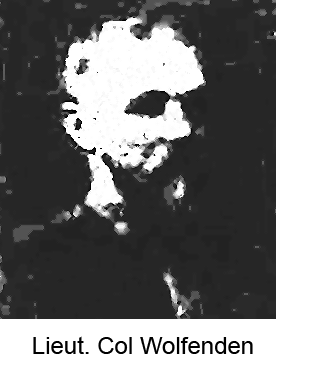 May 8th, 1886, the name of the Regiment was changed to “The British Columbia Brigade of Garrison Artillery” and on the same date Major Wolfenden was promoted to Lieutenant Colonel. May 8th, 1886, the name of the Regiment was changed to “The British Columbia Brigade of Garrison Artillery” and on the same date Major Wolfenden was promoted to Lieutenant Colonel.
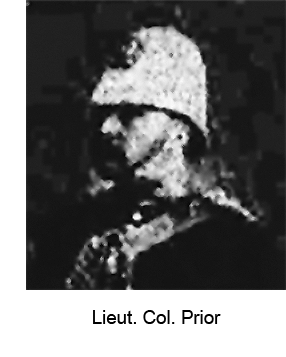 The first unit of the Canadian regular forces arrived here 10th November 1887. It was “C” Battery R.C.A., and escorted by the Brigade to the barracks at Beacon Hill just north of the Albion Cricket Grounds. “C” Battery was stationed there until the erection of Work Point Barracks, after which the old barracks became the Exhibition building of the local Agricultural Association. The first unit of the Canadian regular forces arrived here 10th November 1887. It was “C” Battery R.C.A., and escorted by the Brigade to the barracks at Beacon Hill just north of the Albion Cricket Grounds. “C” Battery was stationed there until the erection of Work Point Barracks, after which the old barracks became the Exhibition building of the local Agricultural Association.
Lieut. Col. Wolfenden retired 5th June, 1888, and was succeeded by Major Prior, who became Lieutenant Colonel 7th July 1888.
In the summer of 1890 Lieut. Col. Prior commanded the Canadian Rifle team sent to England. During this year a detachment of the Brigade was on duty at Wellington, while the miners were on strike.
Drill Hall Built
In 1893 the old drill shed on Menzies street was torn down, and work started on the erection of the large drill hall now there. During the period of construction the Brigade drilled and had its headquarters in the City market, Fisguard street, and for a time the city was relieved of what was then considered a “white elephant.”
May 1893, the name of the Brigade was changed to the “British Columbia Battalion of Garrison Artillery,” with the addition of a battery at Vancouver. Later, in September, the batteries were changed to companies, and renumbered, 1, 2 and 3 being in Victoria, 4 at New Westminster and 5 at Vancouver.
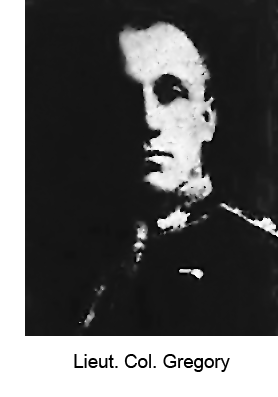 The drill hall was completed in January 1894, and was formally opened by the Lieutenant Governor on the 24th of that month. A promenade concert was given, and refreshments served. The drill hall was completed in January 1894, and was formally opened by the Lieutenant Governor on the 24th of that month. A promenade concert was given, and refreshments served.
In 1896 the designation of the battalion was again changed, this time to 5th Regiment Canadian Artillery, and another company, No. 6, at Vancouver was added to the establishment. Shortly afterwards, the Regiment was divided into two battalions, the Victoria companies becoming the 1st Battalion, under the command of Lieut. Col. F.B. Gregory, and the mainland companies becoming the 2nd Battalion, under the command of Major Townley. Lieut. Col. Prior remained in command of the regiment.
Regiment in Seattle
In 1898, the citizens of Seattle as an expression of their appreciation of British feeling towards the U.S. in its skirmish with Spain, invited the regiment to participate in their Fourth of July celebration. The American and Canadian governments consented and the “Glorious Fourth” saw the old “Dandy Fifth” under arms, master of everything it surveyed on Puget Sound. The “Seattle Spirit” was everywhere in evidence. Nothing was too good for the Canadian soldiers. On the return of the two battalions to Victoria and Vancouver, the Commanding Officer thanked the regiment for having “so well upheld the honor of the regiment under rather trying circumstances.”
The pipe clay equipment was withdrawn from all ranks, except trumpeters in 1899 and the Oliver equipment issued instead. New style serge frocks with breast pockets were also issued. The “pill box” forage cap was retained.
The regiment underwent another change in 1899, for in accordance with Militia Orders 144, July 25th of that year, the 2nd battalion became the “6th Duke of Connaught’s Own Rifles,” and the 1st Battalion became the “5th Regiment Canadian Artillery.”
1899 saw the commencement of the South African war, and the 5th Regt. C.G.A., supplied one officer (Captain M.G. Blanchard) and twenty five other ranks to the half company being formed in British Columbia as part of the special Battalion of the Royal Canadian regiment to serve in South Africa. The quota from the “Fifth” departed from Victoria on Sunday, 22nd October 1899, and on February 18th 1900, Sergeant W.I. Scott and gunners J. Todd, J.H. Somers and A. Maundrell made the supreme sacrifice at the battle of Paardeberg Drift. Captain Blanchard afterwards died of wounds. A tablet erected by members of the regiment in memory of these brave men has been placed in the entrance of the Bay Street Armoury.
In April 1900, a number of men were transferred from the regiment to “A” Company of the 2nd Special Service Battalion, R.C.R. This company was retained here, and for a while was quartered in the Marine Hospital on the old Songhees Reserve. The Sergeant Major of this company was Chris. Hollyer, afterwards pay sergeant of the regiment now serving overseas.
 |
| First Contingent Sent to South Africa in 1899 |
Paraded for “Movie”
The first moving picture performance ever held in Victoria was presented in the drill hall one Saturday evening in May 1900. On this occasion the regiment paraded in uniform. There are many who will remember the consternation caused by the train speeding at sixty miles an hour, straight at the audience, and the mirth provoked when one “cullahed” gentleman pushed another from a bridge into a stream.
In the fall of 1900 the regiment, with the 6th Regt. D.C.O.R., and the companies of R.G. A. and R.E. stationed at Work Point Barracks, was mobilized under active Service at Esquimalt.
Members of the South African contingent returned to Victoria on Thursday, 15th November, 1900, and were welcomed and escorted to the drill hall by the regiment. The Mayor welcomed the veterans home. The parade dismissed, and the band furnished the music for a promenade concert. For several years the Saturday evening promenade concerts given in the drill hall by the band were very popular. Artists of lore were brought from Canadian and American centres, championship basketball was played, and other attractions were given.
Royal Visitors
 During the visit of the King (then the Duke of Cornwall and York) and Queen to Victoria, early in October, 1901, the regiment furnished a guard of three officers and 106 other ranks. This guard, in conjunction with a detachment of the Royal Northwest Mounted Police, was in almost constant attendance on the Royal couple. During the visit of the King (then the Duke of Cornwall and York) and Queen to Victoria, early in October, 1901, the regiment furnished a guard of three officers and 106 other ranks. This guard, in conjunction with a detachment of the Royal Northwest Mounted Police, was in almost constant attendance on the Royal couple.
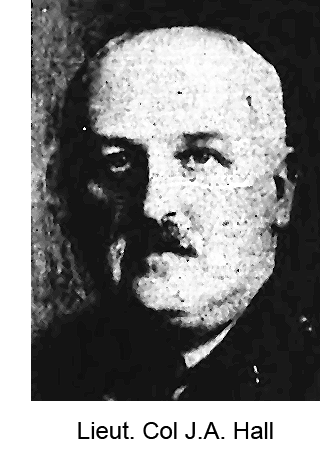 Lieut. Col. Gregory retired December 3, 1901, and was succeeded by Major R. Ross Munro, who was promoted to Lieut. Col. Shortly afterwards. A year later Lieut. Col. Munro resigned. Major J. Parker Hibben and Captains D.B. McConnan and Bryan H. Tyrwhitt Drake waived their claims to promotion, and Captain J.A. Hall took over command of the regiment, 3rd December, 1902, and became Lieutenant Colonel 28th February, 1903. Lieut. Col. Gregory retired December 3, 1901, and was succeeded by Major R. Ross Munro, who was promoted to Lieut. Col. Shortly afterwards. A year later Lieut. Col. Munro resigned. Major J. Parker Hibben and Captains D.B. McConnan and Bryan H. Tyrwhitt Drake waived their claims to promotion, and Captain J.A. Hall took over command of the regiment, 3rd December, 1902, and became Lieutenant Colonel 28th February, 1903.
Another change in uniform came into force in 1906, and the “pill box” forage cap gave place to field service caps. Later the naval pattern cap was adopted, and is now universal in the service.
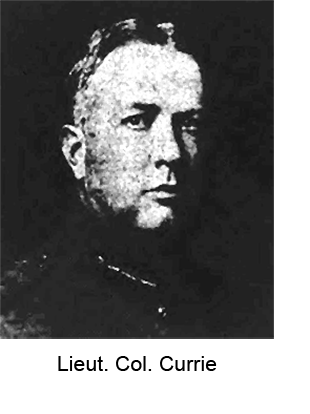 In June 1908, Lieut. Col. Hall commanded the British Columbia contingent to the Quebec Tercentenary Celebration, and 1st September 1909 retired from the command. Major A.W. Currie, who succeeded, was promoted Lieutenant Colonel 20th November, 1909. This officer enlisted in the regiment as a gunner in 1897. In June 1908, Lieut. Col. Hall commanded the British Columbia contingent to the Quebec Tercentenary Celebration, and 1st September 1909 retired from the command. Major A.W. Currie, who succeeded, was promoted Lieutenant Colonel 20th November, 1909. This officer enlisted in the regiment as a gunner in 1897.
On invitation of the management of the A.Y. P. Exposition, the regiment proceeded Sunday 5th September, 1909, to Seattle, and once again enjoyed the hospitality of the Americans.
The remains of the late Lieut. Col. Richard Wolfenden, I.S.O., V.D., were escorted to their last resting place by the officers and men of his old command, Sunday, 8th October, 1891.
The coal miners in Nanaimo, Extension, and Ladysmith went out on strike in August, 1913, and the resulting developments were alarming enough to call out the Militia as an aid to the civil power. On the 13th of the month a detachment of the regiment proceeded to Departure Bay by boat, and the following day another entrained for Nanaimo. Until August 1914, the regiment supplied a large detachment as part of the Civil Aid Force stationed in the coal mining area.
Splendid Record
Victorians have always taken a pride in the proficiency of the “Dandy Fifth” but its standing amongst the other artillery units of Canada is not generally known to them. In 1907, 1909, 1910 and 1913 the regiment won first place in gun practice, and the Turnbull shield. The Lansdowne Cup was won in 1909, 1910 and 1913. The Hugh Blaik Cup for general efficiency in 1909, 1910, 1911, 1912 and 1913. The most coveted honor, the Governor General’s Cup, was won in 1907, 1909, 1910, 1912 and 1913. In 1914 the regiment dropped to second place on account of the large number of men who were a portion of the Civil Aid Force at Nanaimo, and who, in consequence, could not take part in the competition.
In Present War
Of the part the regiment has taken in the Great War the general public is not well informed, and the time has not arrived when all can be told. At this period it is permissible to state that the regiment has done all it has been permitted, but not al that it has sought to do.
On the 2nd of August 1914, two days before the declaration of war on Germany, the 5th Regt. C.G.A. was mobilized for active service, and on duty in the Esquimalt Fortress. The 4th of August found the 3rd (New Brunswick) Regt. C.G.A., in camp at their annual training, and it has claimed the honor of having been the first on service, but as the “Fifth” was officially called out under active service two days before, the honor is hers.
During the last four years the regiment has been on continuous service in the local forts, and has trained and sent to France nearly 1,500 men, of whom 100 were commissioned officers. Considering the fact that the authorized establishment of the unit 373, all ranks, and has not been exceeded, it will be understood how the regiment has carried on.
On the 26th August 1914, the following officers, N.C.O.’s and men left for overseas: Capts. R.P. Clark and P.T. Stern, Honorary Captain Chaplain Rev. Wm. Barton, Lieuts. K.H. Bovill and W.B. Shaw, Color Sergeant Major R. parker, Sgt. F. Young, Cp. W.B. Montieth, Cpl. E. Waller, Bdr. L.C. Diespecker, Bdr. J.M. Burns, Gunners J.B. and J.M. Armstrong, C.T. Balderston, J.M.G. Bell, H.S. V.W. and E.D. Carter, R.A.r. Clark, P. Edmuunds, S.G. Fieldsend, A.S. Grice, S.J. Hodson, K.C. McCallum, E. Macmillan, J.C. Orr, A. Page, P. Serle, F.H. Small, J. Ward, J.A. and W.J. Watson, R.H. Williams and H.G. Warren. Sgt. V. Zals, Cpls. W.G. Eden, E.W. Prior and H.L. Robinson. Bdrs. A.L. Price and T.W. Gaunt and Gunners T.W.F. Alenander, T.W. Bus, J.A. Chisholm, W.C. Clare, B.W.M. Compton, M.P. Harrison, F.C. Hanington, G. Mulcahy and E.V. Robley, Corpls. F. Fox, B. Keogh and G. Paradise, Bdr. Phipps and Gunners A. Corbett, E.D. and E.W. Dingle, E. Dowling, S. Evans, J.E. Farmer, P. Foreman, R. Harvey, H.C. Laundy, T. Loader, C. Morris, A. Phillips, H.J. Ramsay, P.A. Thunder, H. Whaite and J.M. Smith.
This contingent, popularly known as the “Immortal Sixty Eight,” was merged in the 1sr Brigade C.F.A., C.E.F., and has nobly upheld the traditions of the old regiment.
Continuous Drafts
Following the 1st Contingent, the regiment supplied drafts contiuously until very resently. The 10th Bde. Ammun. Col., C.F.A., 15th Bde. C.F.A., and 4th Div. Ammun. Col. C.F.A., were supplied by the “Fifth.” St. Lucia, B. W. I. is garrisoned by “Fifth” men, and there are “Fifth” men serving in almost every fighting battalion in France, and their honors are legion.
Lieut. Col. Arthur Currie is now a Knight, a Lieutenant General, and commands all the Canadians in France.
Lieut. Col. J.A. Hall raised and crossed overseas with the 88th Battalion, C.E.F., and is now attached to the War Office on munitions work.
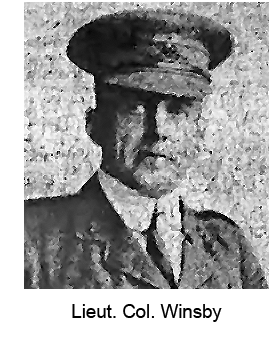 Lieut. Co. Wm. Winsby raised and went over with the 47th Battn., and is now an acting Brigadier General in the Imperial Army. Lieut. Co. Wm. Winsby raised and went over with the 47th Battn., and is now an acting Brigadier General in the Imperial Army.
Captain R.P. Clark, of the First Contingent, has won the D.S.O and M.C., and is now General Staff Officer, Canadian Headquarters, France. Captain P.T. Stern after service in France is now Major and an acting A.P.M. at Liverpool. Captain C.W. Birch, went over with the 10th Bde. C.F.A., and died of wounds.
Space is not sufficient to recount the many promotions and decorations won by the junior officers.
On the home station the men of the “Fifth” have been called upon to perform every duty that a soldier may be expected to do. Whenever men were required for any special purpose, or of any special qualification, the “Fifth” has invariably been called upon to supply them.
All British Columbia knows of the 5th Regiment’s band. The present band was formed twenty five years ago, and during this period has made an enviable record. Under the leadership of Bandmaster J. Finn it played an engagement at the St. Louis World’s Fair, and afterwards toured the large American cities, returning to St. Louis for a second engagement. The present bandmaster, Warrant Officer W.J. Smith assumed his duties in 1914, and under his leadership the band has performed at over four hundred public functions, and has been instrumental in raising many thousands of dollars for patriotic aid, Red and Blue Cross, Belgian and Halifax reliefs, and Prisoner of War and Veterans funds. Sixteen members of the band have served “overseas,” four of whom wear wound stripes, and two have made the great sacrifice.
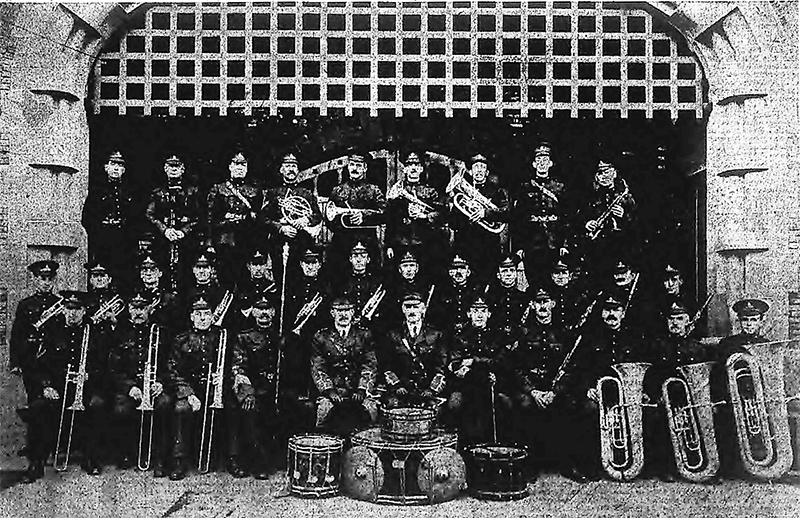 |
| 5th Regimental Band |
On the 15th of this month the regiment was demobilized by 11 M.D. Order 774.
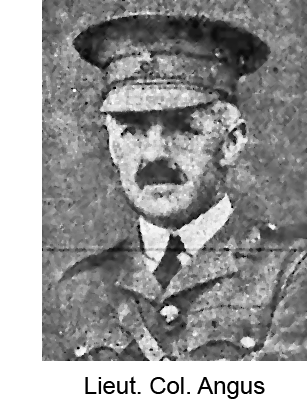 At the time of demobilization the officers were Lieut. Col. Angus, O.C., Major H.H. Woolison, Capt. A.E. Robertson, Capt. W. Walter Winsby, Adjt., Capt. J.F. Grant, M.O., Lieuts. D.R. Finnick, S.H. de Carteret, W.C. Thompson, F.W. Russell, Lieut. Col. Ridgway Wilson, on the regimental reserve, still continues on the district staff. Hon. Lieut. J. Caven is quartermaster. At the time of demobilization the officers were Lieut. Col. Angus, O.C., Major H.H. Woolison, Capt. A.E. Robertson, Capt. W. Walter Winsby, Adjt., Capt. J.F. Grant, M.O., Lieuts. D.R. Finnick, S.H. de Carteret, W.C. Thompson, F.W. Russell, Lieut. Col. Ridgway Wilson, on the regimental reserve, still continues on the district staff. Hon. Lieut. J. Caven is quartermaster.
Most of its personnel was attached to other units for all purposes, and those not within the military ages were released from service until further orders. If these services are again required, the old “Dandy Fifth” will prove that its motto, “Nunquam non paratus” is no idle boast.
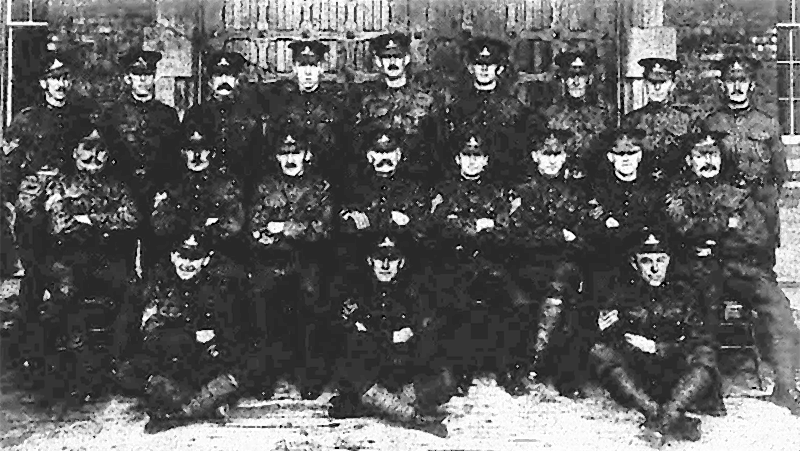 |
| Sergeant's Mess at Time Unit Disbanded |
September 26, 1918
Ten Victorian Soldiers Invited to Join Expedition to States
To Boost Liberty Loan
On Friday evening a “trophy train” will leave Vancouver for Vancouver, Washington, to aid in the flotation of the new Liberty Loan. With the collection of war souvenirs will go fifty discharged crippled returned soldiers and places have been reserved on the party for ten men from this city.
Returned men who have suffered the amputation of either a leg or an arm will be provided with a holiday jaunt free of all expenses if they notify Mr. C.C. Tunnard, 503 Central building, of their desire to take part in the expedition. It is essential that those willing to make the trip should send in their names before 5 o’clock this afternoon as the arrangements for transportation must be made this evening.
MILITARY NOW HAVE ALL WILLOWS AREA
The city council yesterday morning amended the terms of the lease of Willows Park to the Department of Militia so as to transfer to the Government control of the entire area, or seventeen acres more than were originally included.
The mayor explained to the council that Major Ritchie, of the Royal Canadian Engineers, had told him the additional area was needed in anticipation of the Siberian expeditionary force, which is to be stationed here.
The lease is to expire twelve months after the termination of war, and any buildings erected by the military authorities on the grounds are to be sold or removed within 90 days of the expiration of the lease, failing which the city assumes ownership.
Mutiny From Victoria to Vladivostok, December 1918.
Page 245
Evidence of discontent at Willows Camp abounds. In November 1918, 87 soldiers of the 259th Battalion were moved crossing the city to Work Point Barracks. “These men not being anxious to proceed to Siberia.”
The disposition of these men is not known.
COLONIST
October 8, 1918
CITY WILL ACT TO CHECK EPIDEMIC
An excerpt from the article involving the Spanish Influenza situation:
Esquimalt appears to have escaped the epidemic entirely so far. Two soldiers were found to be affected with influenza last week and were promptly put in isolation. There is a regular medical examination of all public school children in the municipality, and Medical Health Officer has reported no cases.
Oak Bay schools will be closed today. No cases of influenza have developed among the civilian population, although there are thirty cases among the soldiers stationed at Willows Camp.
December 3, 1918
ESQUIMALT BOYS ASK TO BE REMEMBERED
West Vancouver Branch of The Red Cross Sent Parcels to
Two Local Lads in England
The West Vancouver branch of the Red Cross has received a letter from a former Esquimalt boy, J.W. Bryan, asking if they would send him and his chum a little parcel. The letter has been forwarded to The Colonist by the secretary-treasurer of the West Vancouver branch of the Red Cross with the suggestion that it be published, and undoubtedly it will prove interesting to friends of the two boys. It was written by J.W. Bryan, P.O.1. R.N.C.V.R. c.o. Mess B2, R.N. Barracks, Devonport, England.
“Dear friends – Would it be asking too much of you to send my chum and I a little parcel? We have just come in for a short while, and with the exception of two parcels, one at Dover and one at the base some time back, we have never heard much of the West at all, and that is in a little over two years, and it sure is good to secure a few of the little home things that we can’t get here. We are both Esquimalt boys and would be glad to hear from you. Thanking you in anticipation for I know you will be kind enough to do this”.
“I am yours sincerely
(Sgnd) J.W. Bryan
“P.S. – My chum’s name is A.G. Bell, P.O. 1. R.N.C.V.R. c.o. Mess B2, R.N. Barracks, Devonport”.
The West Vancouver branch sent two boxes of cake, chocolate, fruits and candy in response to this letter. Perhaps some friends here might be moved to include these boys on their list.
ALL NOW IN FRANCE
1918
“ALL NOW IN FRANCE”
This title is derived from the silver plate bowl I assume was sent to James and Maria Bates from Fred in 1918. Inscriptions on the bowl are: “From FRED ALL NOW IN FRANCE”, “Sonny”, “Jim”, “B”, “1893” and “1918”. The bowl came to dad (Sonny) around 1992 from his sister Rose in Puyallup, Washington. The inscriptions refer that all three boys were in France in 1918, Sonny, Fred and Jim. 1893 was the year that James and Maria were married and B of course for Bates. Sonny was in the 29th Bn CEF, Jim was in the 8th Bn Oxfordshire and Buckinghamshire Light Infantry, BEF, and Fred was in the 4th Divisional Train, CASC, CEF.
Sonny (Arthur) enlisted in the 48th Bn # 2 Coy in Victoria March 12, 1915 as a Drummer # 430523, listing his birth date as June 10, 1896, three years earlier than reality. He served in the 50th Gordon Highlanders militia unit in Victoria as a Bugler from August 10, 1914 to date of enlistment in the 48th Bn. They sailed for England July1, 1915 on the S. S. Grampian from Montreal. The 48th Bn was changed to the 3rd Pioneer (48th Canadians) Bn, in the 9th Brigade of the 3rd Canadian division, and sailed for France March 16th 1916. After the Battle of Vimy Ridge, the 3rd Pioneers were disbanded and Sonny was transferred to the 29th Bn from Vancouver where he remained until the end of the war. He returned from England on the SS Olympic and to Victoria May 24th, 1919.
Fred enlisted as a Driver in the CASC in Victoria November 15, 1916, # 200088, after serving in 21 Coy, CASC in Victoria for six months, and perhaps some time in the 50th Gordon Highlanders, also in Victoria. Through a series of transfers he sailed for England January 24, 1917, then onward to France arriving September 18, 1917, and eventually was posted to the 4th Divisional Train, CASC, October 8, 1917. He returned from England on the SS Olympic and to Regina June 13, 1919 and back to Victoria.
At some point in time he wished to be called Frank, and so it was from then on.
Fred searched for and found Sonny at a concert one night when the 29th was in a rest location behind the lines after the Battle of Passchendaele in November 1917.
Jim returned to England, aboard the S.S. Metagama sailing from Montreal to Liverpool in May 1916 and enlisted in the Imperial Forces RASC as a Driver, # 186819, in Woolwich on June 8, 1916, addressed at # 6 Gildersome St in Woolwich, the family home in 1912. He transferred to the 8th Bn, Oxford & Bucks Light Infantry as a Private, # 31000, on June 27, 1916 at Morn Hill Camp, Winchester. He served in France from January 23, 1917, and Salonika, Greece, from November 11, 1917. He repatriated (Free Passage option) back to Canada from (friends Mr. & Mrs. Steele) 14 Crown Road, Southern Cross, Portslade, Brighton, Sussex, aboard the S.S. Aquitania from Liverpool on May 17, 1919. He transferred to the Army Reserve in Victoria on June 27, 1919.
In my research of the family in WW1 I found that they had an uncle in the CEF, Robert Frederick Bates, b. 1875 in India, a younger brother of their father, James. He spent 19 years in the RFA / RHA until August 4, 1911, and had been a Gnr, # 5539 in # 1 Coy RCGA (PF) at the Citadel in Halifax since January 17, 1912 and transferred to the 9th Siege Battery on July 18, 1916, # 1257526. He left Canada on September 26, 1916 for England and proceeded to France March 21, 1917 until April 16, 1919. He sailed from England for Canada May 18, 1919 and transferred to the RCGA, MD # 6 in Halifax, at the Citadel, May 21, 1919 where he remained until being discharged June 29, 1923.
Perhaps if Fred had known this he would have included the older (uncle) Robert Frederick, his name sake, on the bowl.
— Jack
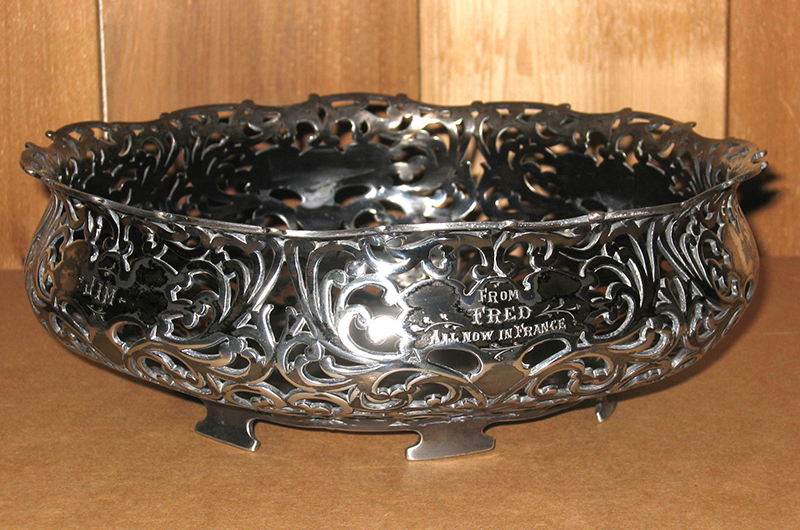 |
| All Now In France |
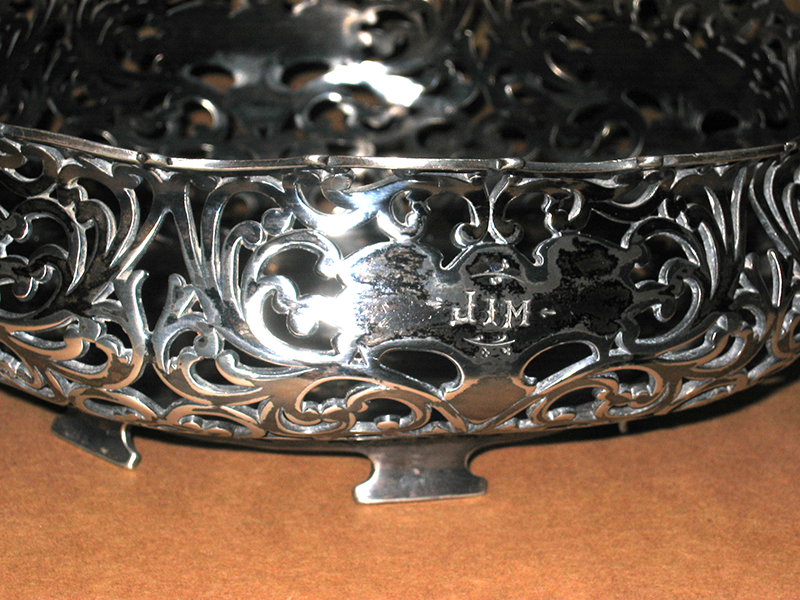 |
| All Now In France |
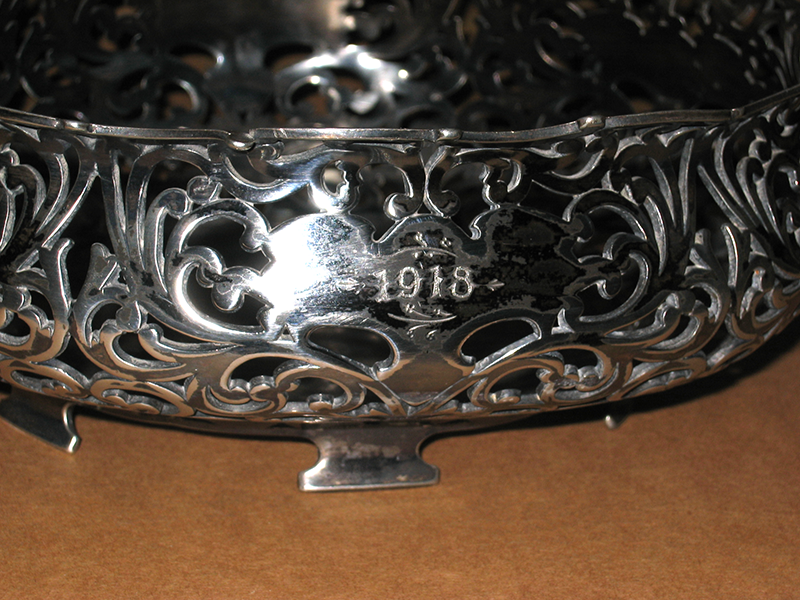 |
| All Now In France |
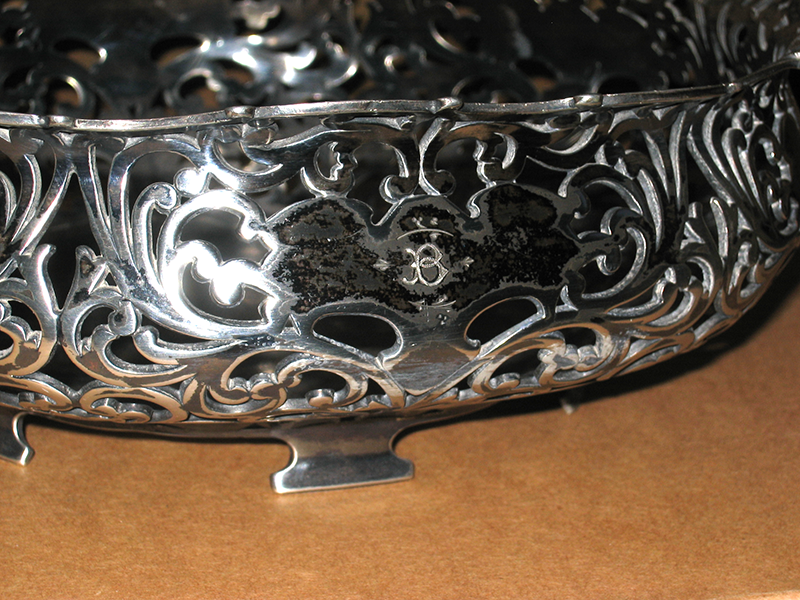 |
| All Now In France |
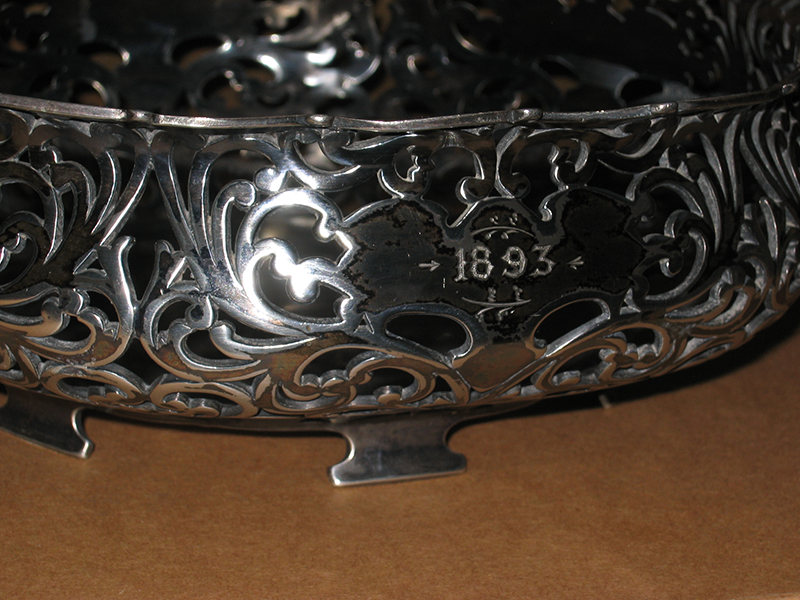 |
| All Now In France |
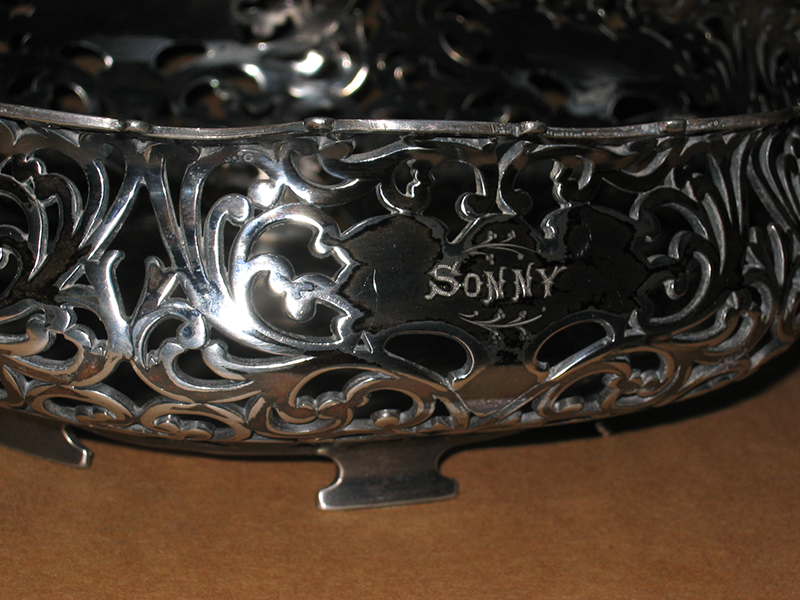 |
| All Now In France |
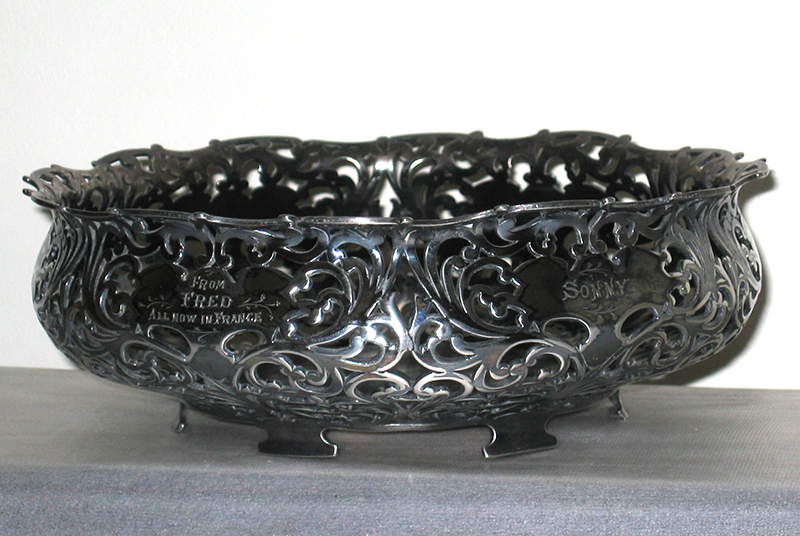 |
| All Now In France |
... continued in 1919 ...
|

